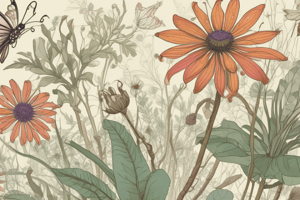Podcast
Questions and Answers
What happens when the insect gathers nectar from a flower?
What happens when the insect gathers nectar from a flower?
- The insect rubs against the anthers and collects pollen. (correct)
- The insect releases pollen into the flower.
- The insect creates nectar as a byproduct.
- The insect absorbs nutrients directly from the flower.
What aspect of the flower attracts the insect after it has fed on nectar?
What aspect of the flower attracts the insect after it has fed on nectar?
- The texture of the petals.
- The bright colors of the flower. (correct)
- The shape of the flower.
- The scent of the flower.
Why does the insect move to another flower after feeding?
Why does the insect move to another flower after feeding?
- To pollinate the flower.
- To escape predators.
- To find a brighter color.
- Because it gets hungry. (correct)
Which part of the flower transfers pollen to the insect?
Which part of the flower transfers pollen to the insect?
What is the initial interaction between the insect and the flower during nectar gathering?
What is the initial interaction between the insect and the flower during nectar gathering?
What is one primary reason some flowers produce nectar?
What is one primary reason some flowers produce nectar?
What purpose do patterns or marks on flower petals serve?
What purpose do patterns or marks on flower petals serve?
Which type of flower is least likely to produce nectar?
Which type of flower is least likely to produce nectar?
Why might some flowers not have any visible patterns or marks on their petals?
Why might some flowers not have any visible patterns or marks on their petals?
What might be a disadvantage of producing nectar for flowers?
What might be a disadvantage of producing nectar for flowers?
What is likely to happen if you bite into a powdered donut without using your hands?
What is likely to happen if you bite into a powdered donut without using your hands?
What would you observe about the texture of the plain donut when taking a bite without hands?
What would you observe about the texture of the plain donut when taking a bite without hands?
What is likely to happen to the powdered sugar when biting into a donut without wiping your mouth?
What is likely to happen to the powdered sugar when biting into a donut without wiping your mouth?
What sensory experience is most influenced by eating a plain donut without using your hands?
What sensory experience is most influenced by eating a plain donut without using your hands?
What is a potential consequence of not using your hands while eating a donut?
What is a potential consequence of not using your hands while eating a donut?
What occurs as the insect feeds on the nectar of a new flower?
What occurs as the insect feeds on the nectar of a new flower?
Which part of the second flower receives the pollen from the insect?
Which part of the second flower receives the pollen from the insect?
What does the insect gather as it moves from one flower to another?
What does the insect gather as it moves from one flower to another?
What is the primary function of pollen in this context?
What is the primary function of pollen in this context?
How does the insect play a role in the reproduction of flowers?
How does the insect play a role in the reproduction of flowers?
What distinguishes self-pollination from other types of pollination?
What distinguishes self-pollination from other types of pollination?
During self-pollination, which part of the flower receives the pollen?
During self-pollination, which part of the flower receives the pollen?
In self-pollination, what role does the anther play?
In self-pollination, what role does the anther play?
Which of the following statements about self-pollination is accurate?
Which of the following statements about self-pollination is accurate?
What is a potential disadvantage of self-pollination?
What is a potential disadvantage of self-pollination?
Flashcards are hidden until you start studying
Study Notes
Pollination
-
Nectar is a sweet liquid produced by flowers to attract pollinators, primarily insects.
-
Patterns and marks on flower petals serve as visual cues for pollinators, guiding them towards the nectar.
-
When an insect feeds on nectar, it rubs against the anthers, which transfer pollen onto the insect.
-
Attracted by bright colors, the insect moves to another flower.
-
The pollen from the previous flower is transferred to the stigma of the new flower, facilitating pollination.
Self-Pollination
- Involves pollen transfer from anther to stigma within the same flower.
- A simpler form of pollination compared to cross-pollination, which involves different flowers.
Studying That Suits You
Use AI to generate personalized quizzes and flashcards to suit your learning preferences.




